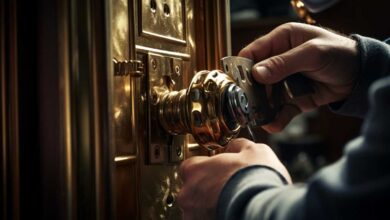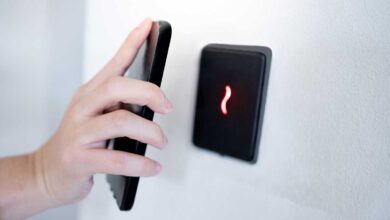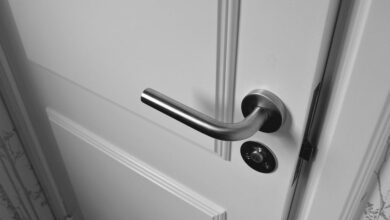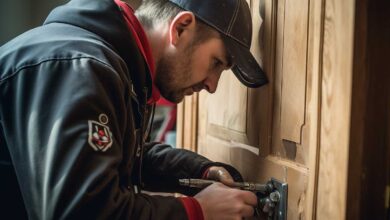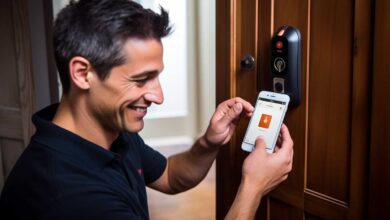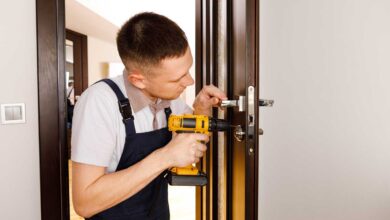Common Issues With Home Locks And Their Solutions
KEY TAKEAWAYS
Home security is paramount, and the first line of defense is often the locks on our doors. Over time, even the most robust locks can develop issues. Understanding these problems and their solutions can ensure that your home remains a safe haven.
Discover the common issues with home locks and their solutions. This guide offers expert solutions to help you secure your home.
The Importance Of Reliable Locks
Locks play a pivotal role in our daily lives. They protect our homes, our families, and our valuables. A malfunctioning lock can compromise the safety of all these. Hence, timely identification and resolution of lock issues are crucial.
Common Lock Problems And Their Solutions
Home locks can encounter various problems, and it’s important to recognize these issues and learn how to solve them.
Sticking Or Jammed Locks
Cause: Over time, dirt and grime can accumulate inside the lock, causing it to stick or jam.
Solution: Regularly clean and lubricate your locks. If the problem persists, consider replacing the lock or consulting a locksmith.
Key Breaks Inside The Lock
Cause: Applying too much force or using a worn-out key can cause it to break inside the lock.
Solution: Use needle-nose pliers to try and extract the broken piece. If unsuccessful, call a professional locksmith.
Lock Doesn’t Latch Properly
Cause: The door or frame may have shifted over time, causing misalignment.
Solution: Adjust the strike plate. If the problem persists, the entire lock mechanism might need a replacement.
Door Knob Or Handle Is Loose
Cause: Frequent use can wear out the screws or set pins.
Solution: Tighten the screws on the door knob or handle. If they’re stripped, replace them.
Difficulty Turning The Key
Cause: The internal mechanism of the lock may be worn out, or the key itself might be damaged.
Solution: Try using a spare key. If the issue remains, it might be time to replace the lock.
Preventative Measures For Lock Longevity
To ensure the longevity of your locks:
-
Regular Maintenance: Clean and lubricate locks regularly to prevent accumulation of dirt.
-
Use Quality Keys: Always use sturdy, well-made keys to prevent breakage.
-
Professional Installation: Ensure locks are installed by professionals to guarantee they function correctly.
-
Routine Checks: Periodically check the alignment of your doors and the condition of your locks.
When To Consult A Locksmith
While many minor lock issues can be resolved with a bit of DIY, there are times when consulting a professional locksmith is the best course of action. If you’re facing persistent problems or if you’re unsure about the security of your current locks, it’s wise to seek expert advice.
The Importance Of Understanding Your Lock Type
Different lock types serve different purposes and have distinct mechanisms. Recognizing the type of lock you have and understanding its potential issues can be the difference between a secure home and a vulnerable one.
Traditional Locks
Traditional locks have several issues that can compromise the security of your home or office.
Sticking Or Jammed Locks
Cause: Dirt, grime, or rust accumulation.
Solution: Clean the lock with a suitable solvent and lubricate with graphite powder or silicone-based lubricant.
Key Doesn’t Turn
Cause: Worn-out key or internal mechanism.
Solution: Try a spare key. If the issue persists, consider replacing the lock cylinder or consulting a locksmith.
Common Issues with Keyless Door Locks
While keyless door locks offer convenience and improved security, they are not without their challenges.
Fails To Unlock
Cause: Dead batteries or misaligned latch.
Solution: Replace the batteries. If the lock still doesn’t work, realign the door latch.
Unresponsive Touchpad
Cause: Dirt or smudges on the touchpad.
Solution: Clean the touchpad gently with a soft cloth. Avoid using abrasive materials.
Keypad Locks
Keypad locks, while offering a convenient and secure method of access control, are not without their issues.
Keypad Doesn’t Light Up
Cause: Power source disruption.
Solution: Ensure the power source (usually batteries) is functional and properly connected.
Incorrect Code Errors
Cause: The code memory may be full or there’s an electronic glitch.
Solution: Reset the lock and reprogram the codes. If the issue persists, consult the manufacturer or a locksmith.
Smart Lock Devices
Smart lock devices, while convenient, can face several issues that can compromise their efficiency and reliability.
Connectivity Issues
Cause: The lock may be out of range from the hub or there’s interference.
Solution: Move the hub closer to the lock or remove potential sources of interference like other electronic devices.
Mobile App Malfunctions
Cause: Software glitches or outdated app versions.
Solution: Ensure your app is updated. If problems persist, reinstall the app or consult the lock’s customer support.
Unauthorized Access Alerts
Cause: The lock may detect tampering or repeated failed access attempts.
Solution: Review access logs to identify the source. Update passwords and consider enhancing security measures.
Proactive Measures For All Lock Types
-
Regular Maintenance: Regardless of the lock type, regular cleaning and maintenance can prevent many common issues.
-
Stay Updated: For technologically advanced locks, ensure software or firmware is always updated.
-
Professional Consultation: When in doubt or when facing persistent issues, always consult a professional locksmith or the manufacturer.
Common Problems With Home Locks
Locks are the guardians of our homes, silently standing guard against potential intruders. However, like any other mechanism, they can face issues over time, rendering them ineffective. According to the National Crime Prevention Council, around 34% of burglars enter through the front door.
Broken Or Jammed Lock Cylinders
The lock cylinder is the part of the lock where the key is inserted. Over time, due to wear and tear or external damage, the cylinder can become jammed or broken.
Causes
-
Forced Entry Attempts: Burglary attempts using tools can damage the cylinder.
-
Key Issues: Using the wrong key or a damaged key can jam the cylinder.
-
Environmental Factors: Rust due to moisture or freezing temperatures can cause the cylinder to jam.
Solutions
-
Lubrication: Regularly lubricate the lock cylinder to prevent jamming due to environmental factors.
-
Professional Repair: If the cylinder is broken, it’s best to consult a locksmith for a replacement or repair.
Misaligned Lock Strike Plate
The strike plate is the metal plate attached to the door frame into which the lock bolt enters. Misalignment can prevent the door from locking securely.
Causes
-
Door Or Frame Shifting: Over time, doors and frames can warp or settle, causing misalignment.
-
Improper Installation: If the strike plate wasn’t aligned correctly during installation, issues can arise.
Solutions
-
Adjustment: Loosen the screws, realign the strike plate, and tighten.
-
Professional Assessment: If realignment doesn’t solve the issue, a locksmith can assess and provide a solution.
Faulty Internal Mechanism Or Components
Locks are intricate devices with various internal components. If any of these components malfunction, the entire lock can become compromised.
Causes
-
Wear And Tear: Over time, internal parts can wear out.
-
External Damage: Forced entry or tampering can damage internal components.
Solutions
-
Regular Maintenance: Periodic checks and maintenance can prevent sudden malfunctions.
-
Replacement: If a specific component is faulty, it may need replacement. In some cases, replacing the entire lock might be more cost-effective.
Power Outage, Power Supply, Or Battery Issues
Modern locks, especially smart locks, rely on power for functionality. A disruption in power supply can render these locks inoperative.
Causes
-
Power Outages: Unexpected power cuts can affect electrically powered locks.
-
Battery Depletion: Battery-operated locks can malfunction if the battery is drained.
-
Faulty Wiring: Damaged wires or connections can disrupt power.
Solutions
-
Backup Power: Always have an alternative power source or backup batteries.
-
Regular Battery Checks: For battery-operated locks, routinely check and replace batteries.
-
Electrical Assessment: If there are power supply issues, consult an electrician or the lock manufacturer.
Frequently Asked Questions
We have addressed some of the most commonly asked queries to provide you with a better understanding of the common issues with home locks and their solutions.
What causes a lock cylinder to jam?
Lock cylinders primarily jam due to external factors and wear and tear. Forced entry attempts can physically damage the cylinder. Using an incorrect or damaged key can misshape the internal pins. Additionally, environmental factors, such as rust from moisture or freezing temperatures, can hinder the cylinder’s movement, causing it to jam.
How can I prevent my door or frame from shifting and causing misalignment?
To prevent door or frame shifting, ensure that the installation is done correctly from the outset. Regularly inspect for signs of wear, warping, or damage. Addressing minor issues promptly can prevent larger shifts. Additionally, using weather stripping and maintaining consistent indoor humidity can reduce the chances of wood doors and frames warping over time.
Are traditional locks more reliable than modern smart locks?
Traditional locks and modern smart locks serve different purposes and have distinct advantages. Traditional locks, being purely mechanical, are less prone to electronic malfunctions and power-related issues. On the other hand, smart locks offer advanced security features, remote access, and monitoring capabilities. The reliability of either type largely depends on the quality of the product, its installation, and regular maintenance.
How often should I check and replace the batteries in my battery-operated lock?
For battery-operated locks, it’s advisable to check the batteries every 3-6 months. The longevity of batteries can vary based on the lock’s usage, the type of battery, and the specific lock model. Some smart locks provide alerts or indicators when the battery is low, ensuring you’re never caught off guard.
Can I fix a faulty internal lock mechanism myself?
While some minor issues with locks can be addressed with DIY solutions, internal mechanism problems often require a nuanced understanding of the lock’s design. Attempting a DIY fix without proper knowledge can compromise the lock’s integrity and security. For complex issues, it’s always recommended to consult a professional locksmith.
What should I do if my electric lock stops working during a power outage?
For electric locks, it’s essential to have a backup plan. Many smart locks come equipped with traditional key access for such scenarios. Additionally, investing in a lock with a backup battery system can provide temporary power during outages. Regularly checking the backup battery’s health ensures you’re prepared for unexpected power disruptions.
Fixing Common Lock Issues
Locks, while robust, are not immune to problems. Regular maintenance, a keen eye for early signs of issues, and timely professional intervention can ensure that your home remains secure. From the rudimentary traditional locks to the advanced smart lock devices, understanding the potential issues and their solutions is crucial. Regular maintenance, staying updated with technological advancements, and seeking professional advice when needed will ensure that your home remains a fortress against unauthorized access.
Discover more about how to keep your house and family safe by reading our in-depth guide on smart door locks. For additional information, visit Security Forward and explore our resources and guides.
